The 14th century friar William of Ockham would probably cringe to know that his lofty and articulate principle “Non sunt multiplicanda entia sine necessitate” has been boiled down to “Keep it Simple.” The Latin translates to “Entities should not be multiplied without necessity”, but in the Information Age it is usually applied to shave away (using the razor) all but the essence of the issue, and look for the simplest answer. I’ll admit to a three-part bias that I bring to engine data analysis; 1- there is an explanation, 2 – with enough time and information we can find it, and 3- it’s caused by something mechanical or physical that we can fix or adjust.
If you’re a crossword puzzle fan like me, you start with the presumption that each box contains a letter, and sometimes – with little or no clue from the puzzle creator – you discover that the solution demands a number in the box, or two letters, or an emoji or some other variation on the theme. That moment, when you eventuallty abandon the Occam way and solve the puzzle, is gratifying.
Since it’s the New Year, I resolve to continue to find interesting patterns that challenge our thinking, but they won’t all have simple solutions. As we saw last year with the filter paper in the airbox or the engine monitor dutifully logging an engine cooldown in the hangar, sometimes you can’t think far enough outside the box to guess the solution. But it’s the thinking that matters, and how we use the razor to shave away possibilities and arrive at an explanation.
Let’s start the year off with data from a Continental IO-520-C from a Beech 58 Baron using an AuRACLE 2120 with a 2 sec sample rate. Here’s data from the whole flight.
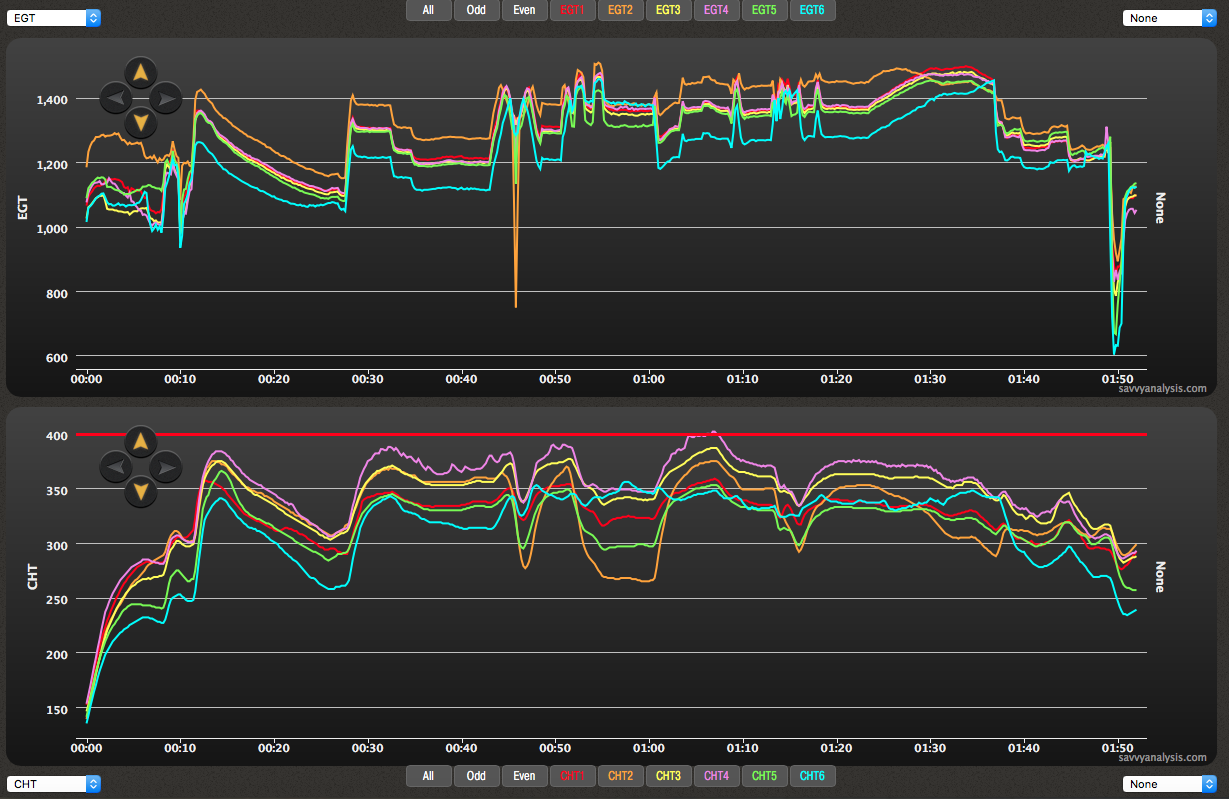
Looking at EGTs, 1, 3, 4 and 5 are packed together, 2 – the brown trace – is high and 6 – the cyan trace – is low. Looking at CHTs, 4 – the purple trace – is slightly high at takeoff, then hottest in cruise until power is reduced for landing. The trace for EGT 2 is about 70º hotter than the others, which is in the range we see with a bad plug. (Quick refresher; bad plug = slower combustion = hotter EGT when the exhaust valve opens.) Let’s see what Occam lets us shave away. The traces for EGT and CHT 2 track together most of the time, but not always. So that’s a vote, but not a certainty, for an injector clog versus a bad plug. What else can the data tell us? Zooming in using GAMI mode, here are the mixture sweeps around the 45 minute mark.
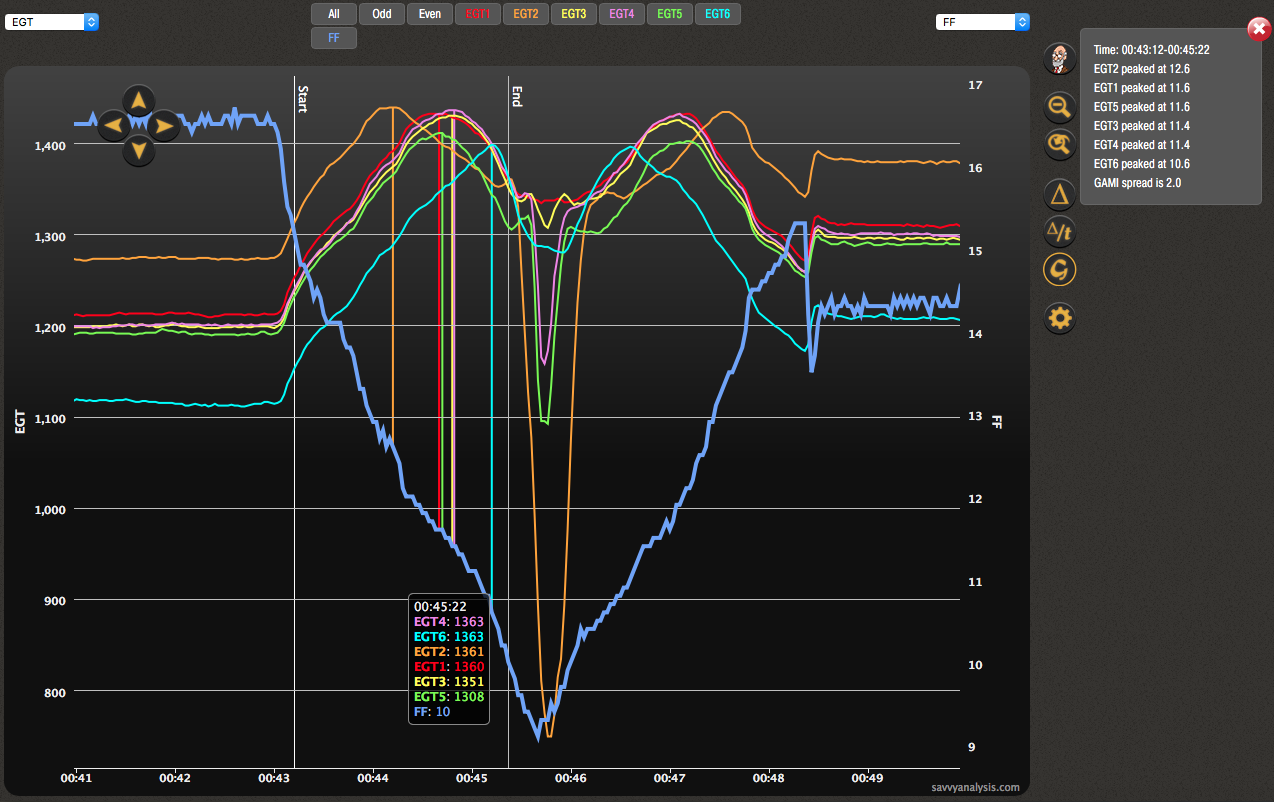
EGT 2 peaks first when leaning, and last when richening, and flames out at the lean point while others continue to fire — all characteristics of an injector clog. To validate our theory, let’s zoom in to the mag check just after the 50 minute mark.
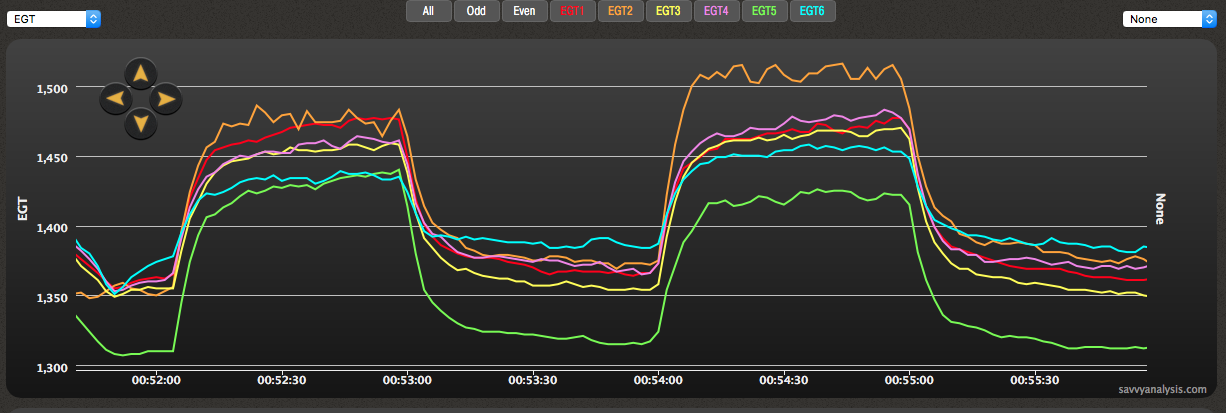
The jagged brown lines of cyl 2 indicate weak spark on both mags. That shouldn’t happen with a bad plug, but is another characteristic of an injector clog. Just to touch all bases, if both plugs were bad – a dead jug – we’d expect low EGT and very low CHT. When it comes to injector clogs, our protocol is to recommend cleaning and re-testing before recommendations for swapping.
Let’s look at cyl 4 on the same engine. EGT is great in cruise, right in the pack. It does begin to flame out at the lean point of the sweep, but it’s ok in the mag check and doesn’t show signs of misfire. The added heat in CHT 4 seems to be coming from cooling, not combustion. It’s hot right after engine start and stays hot through takeoff, cruise and approach. Here we’d recommend checking engine baffles, and let’s hold that thought for a moment and look at EGT and CHT 6.
Is it as simple as concluding that 6 is the mirror image of 2, and the richer mixture causes the lower CHT? Until the mag check, that’s plausible, but there’s a big climb in EGT 6 during approach – around 01:37 – followed by a precipitous drop. It would be tempting to blame a bad probe, but CHT 6 at that point does corroborate the drop – if not the climb. But CHT 6 has been suspiciously high and non-conformist since the mixture sweeps. Now let’s return to that held thought about CHT 4. Occam might say that if 4 is hot and 6 is cool, and because they’re adjacent, then an intercylinder baffle is “stealing” 4’s air and deflecting it to 6. We’re not sure that’s the whole story on 6, but we would start by looking at the cooling.
One of the givens in engine data analysis is that CHT probes are always in the same places – either a bayonet probe inserted into the cylider, or a gasket probe under one of the plugs – and that EGT probes are sometimes high on the stack and sometimes low on the stack, depending on who installed them and how much room they had to work with. So in this case it’s possible that the probe for 6 is further down the stack than the others, and its EGT will track low. On this Continental, 6 is in front, and that introduces a variable determined by airflow, angle of attack, and maybe P factor and yaw. So much for Occam and simplicity.
Here’s data from a Continental IO-550-N from a Cirrus SR-22 using an Avidyne running R8 with a 6 sec sample rate. This is the entire flight with the standard display of EGTs on top and CHTs on bottom. I have added FF – the blue trace – on top and, because we’re not logging GPS data, we’ll use OAT – the yellow trace – as a proxy for altitude.
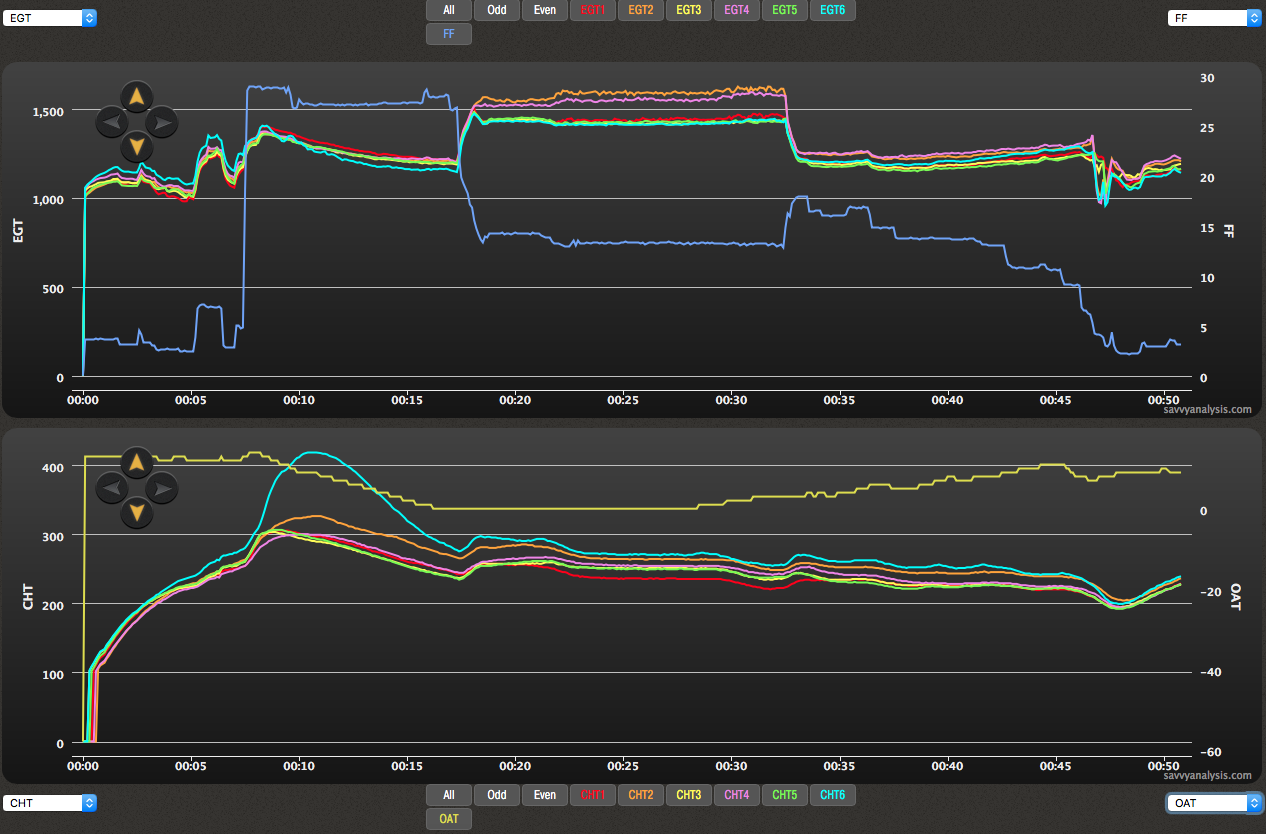
The most obvious anomalies are the high CHT for 6 at takeoff, and the high and slightly erratic EGTs for 2 and 4 in LOP cruise. Here’s the same data with EGT and CHT for 1-3-5 on top and EGT and CHT for 2-4-6 on bottom. Let me highlight the range for the right hand values – on the top chart they peak at 300º, on the bottom it’s 400º. The EGT range on the left is the same top and bottom.
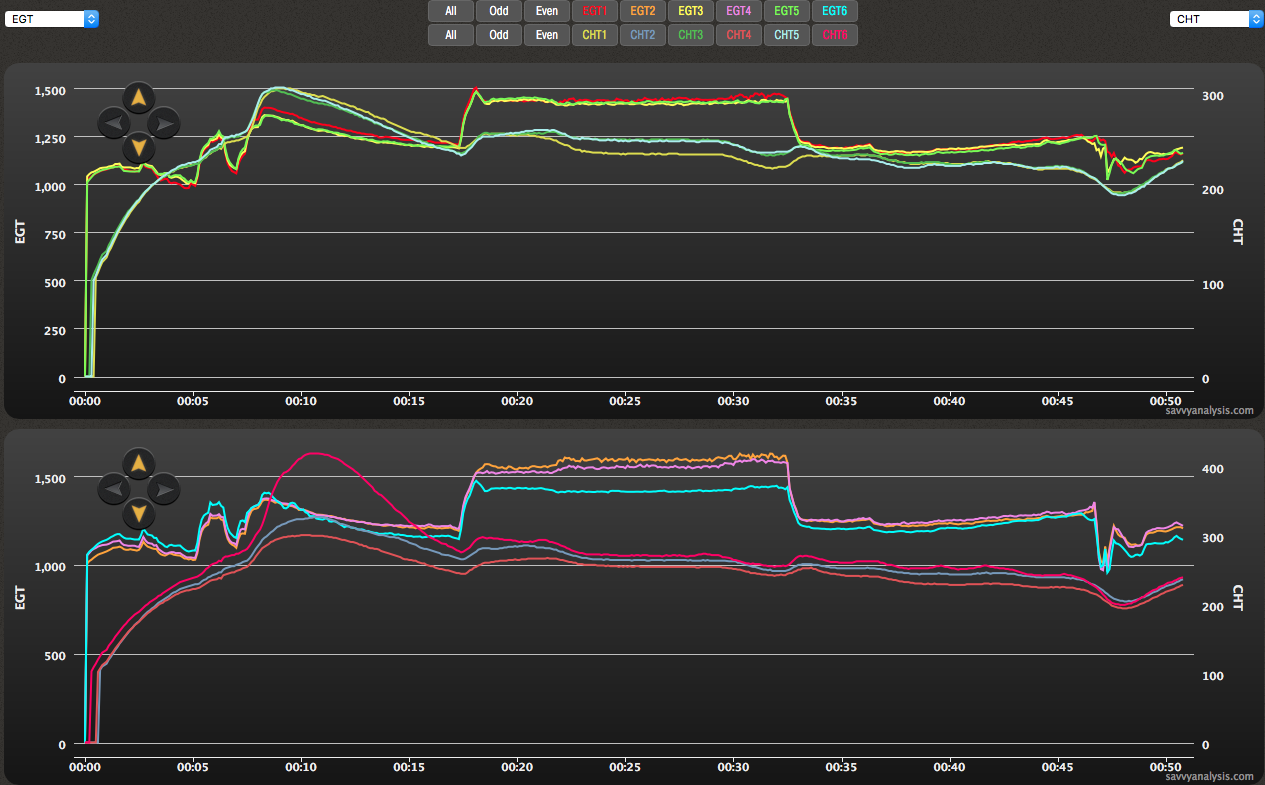
Isolating the odds from the evens shows that the problem seems confined to the even side. 6 seems to be most erratic after engine start and in takeoff and climb, then it settles down in cruise. 2 and 4, on the other hand, are ok in takeoff and climb, and are most erratic in cruise. RPM is not displayed, but is reduced at about the 32 minute mark when EGTs fall.
Of our universe of possibilities, the razor would shave away clogs in all three even injectors (2-4-6) simultaneously while the odds seem normal. And bad gas would effect them all. Ditto all plugs on the even side failing or fouling simultaneously while the odds seem ok. What does that leave us with? Is there a clue in the more erratic behavior during high RPMs?
We recommended checking the ignition system, because this looked like something related to the mags, although a bad mag should ripple through all EGTs, not just the evens. Plugs and harnesses checked out ok, but the mechanics found 30º of play in the distributor gear on the L mag. Partial failure and intermittent behavior challenge our adherence to Occam’s Razor.
I used the common and current spelling for Occam but William was “of” Ochkam, near Surrey, England, which has some aviation history. In 1944 Vickers began using a grass strip near Wisley, in the parish of Ockham, to test new planes. The field was paved in 1952 but closed 20 years later when it was deemed too short and too close to Heathrow. In recent years Wisley has served as a film location for War Horse and Hope and Glory.